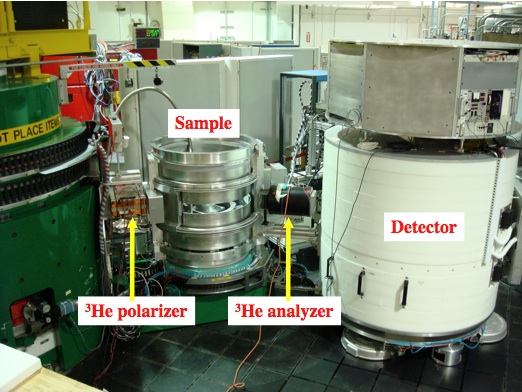BT7 Polarized Beam Operation
A polarized beam option has been developed for BT-7, utilizing 3He polarizers immediately before and after the sample. This gives BT-7 full polarized beam capability for experiments where a guide field (only) is applied at the sample position to control the direction of polarization, and thereby the cross sections. The system is fully operational. The 3He itself can be inverted to achieve the alternate spin state before or after the sample. An adjustable guide field at the sample position is under computer control to manipulate the polarization direction perpendicular or parallel to the scattering plane, or in an angular range in the scattering plane. Spin Flippers are no longer used.
A vertical-field polarized beam option with the 7 T magnet, at relatively modest fields of 2 T and below, is also available for BT-7.
Please note that optically pumping the cells takes ~1 day to get good 3He polarization, and other instruments use the polarizers as well. Hence the use of the polarized beam option must be requested and scheduled well in advance of an experiment.
Sample Mounting for Polarized Beam Operation.
There are special requirements that must be taken into account when mounting samples for polarized beam measurements. In particular, no stainless steel of any kind should be used in or on the sample container, as that can cause uncontrolled depolarization of the neutrons. In addition, non-magnetic screws such as aluminum or brass screws should be used to mount the sample onto the copper block, for example in a closed cycle refrigerator.
For operation below 1.5 K, in a dilution or 3He3refrigerator, additional care should be used to avoid superconducting materials. Cd inside the sample container has caused problems (TC = 0.52 K, HC = 2.8 mT). Pure aluminum has TC = 1.2 K, HC = 10 mT; 6061 Al alloy used for sample mounts and containers has a lower or no transition, depending on the detailed compoisiton and fabrication history, and can also cause problems in some circumstances.
In addition to the BT-7 instrument publication
Double Focusing Thermal Triple Axis Spectrometer at the NCNRJ. W. Lynn, Y. Chen, S. Chang, Y. Zhao, S. Chi, W. Ratcliff, II, B. G. Ueland, and R. W. Erwin, Journal of Research of NIST 117, 61-79 (2012) ,
please use the following publication to acknowledge polarized beam work on BT-7:
3He Neutron Spin Filters for a Thermal Neutron Triple Axis Spectrometer, W. C. Chen, G. Armstrong, Y. Chen, B. Collett, R. Erwin, T. R. Gentile, G. L. Jones, J. W. Lynn, S. McKenney and J. E. Steinberg, Physica B 397, 168 (2007).
For publications that have utilized the polarized beam capability on BT-7, see the Triple Axis Neutron Spin Filters webpage.
______________________________________________________________

Contacts
-
(301) 975-6246

